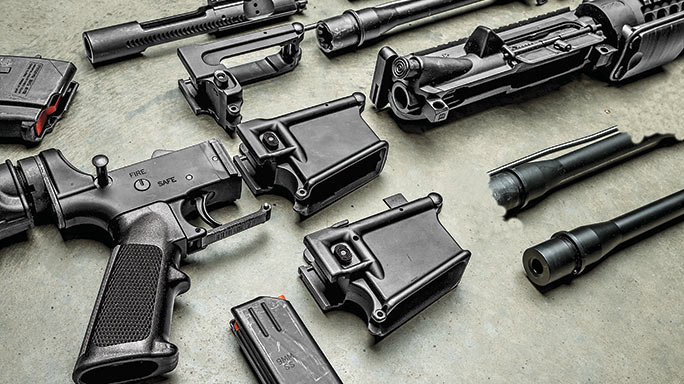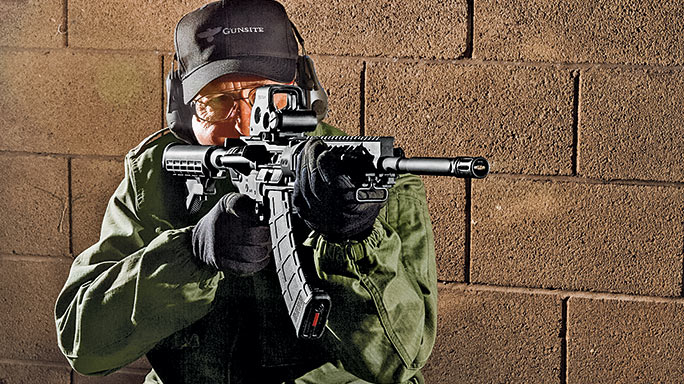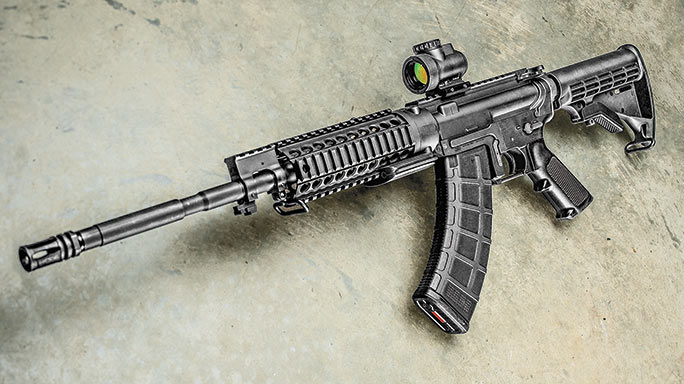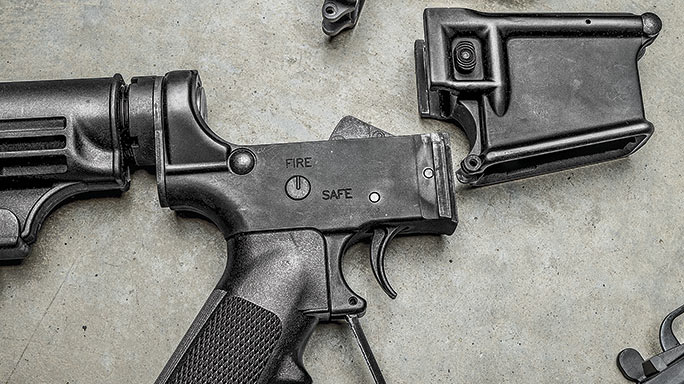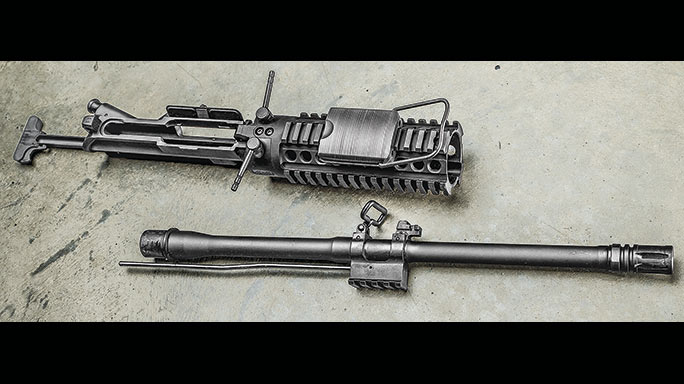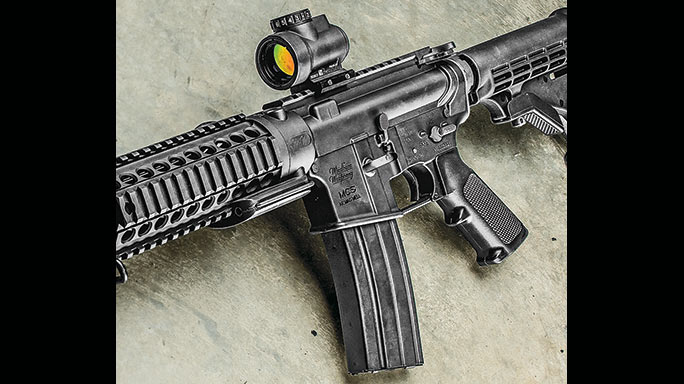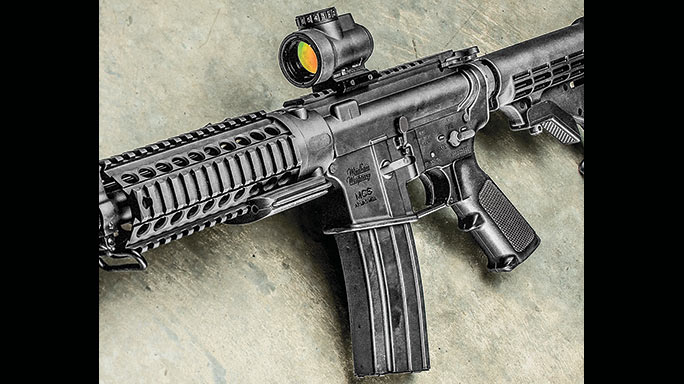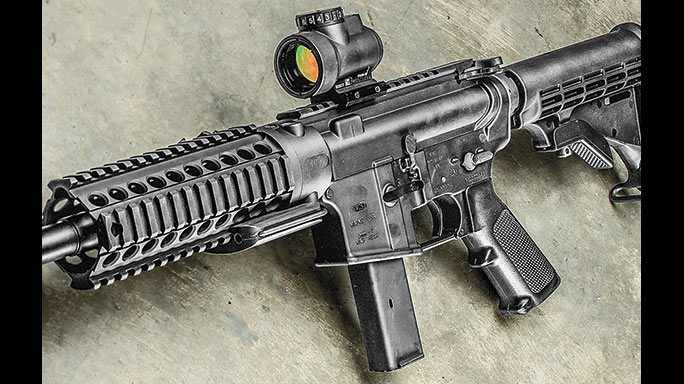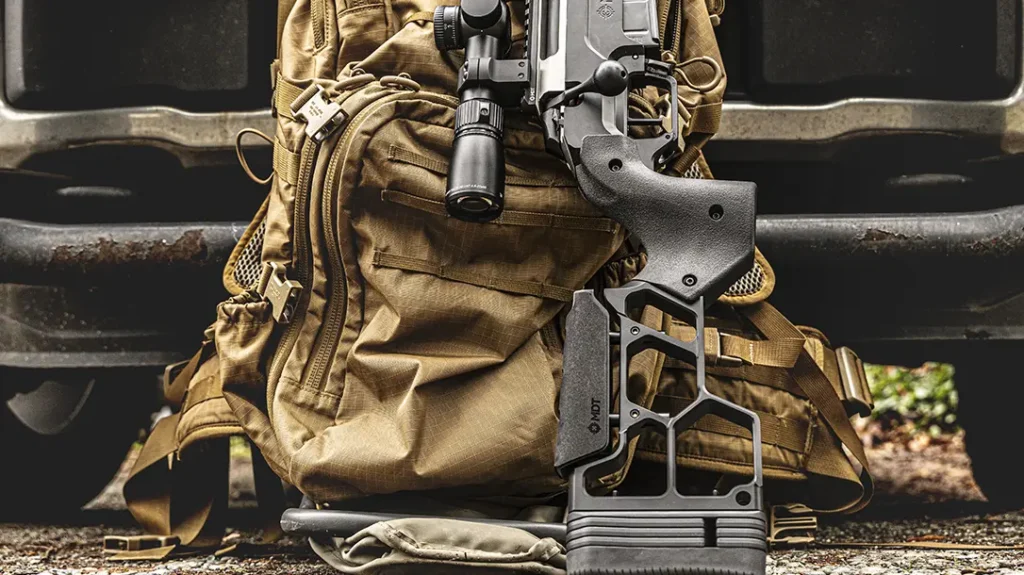The term “special weapon” certainly applies to Windham Weaponry’s RMCS-4 rifle. With only one upper and lower receiver, the gun comes with the parts necessary to change chamberings in a matter of seconds from 5.56mm NATO to 300 Blackout, 7.26x39mm or 9mm Luger.
- RELATED STORY: MCS: Windham Weaponry’s Multi-Caliber System Rifles
Although there are two other Multi-Caliber System versions—the RMCS-2, which can switch between 5.56mm and 300 BLK, and the RMCS-3, which can switch between the 5.56mm, 300 BLK and 7.62x39mm—I recently got my hands on the four-caliber version, the RMCS-4.
Multi-Caliber System
Advertisement — Continue Reading Below
For the shooter who wants to change calibers in seconds because of operational needs or ammunition availability, one of Windham’s RMCS rifles will solve the problem. And for the shooter who just likes gadgets, there is a lot of fun to be had in switching from one chambering to another in the field. The only tool required is a small punch to compress the pin holding the triggerguard in place, but Windham supplies it. In fact, the punch is part of an orange-colored chamber flag that includes a larger punch to push the takedown and pivot pins for disassembly.
Each caliber has a dedicated barrel that must be installed, but the 5.56mm NATO and 300 BLK share the same magazine, magazine well and bolt carrier group. With the 9mm and 7.62x39mm barrels, you’ll also have to change out the bolt carrier group, magazine well and magazine.
With all of the parts installed, the outward appearance of the gun does not change significantly except for the magazine in the case of 9mm or 7.62x39mm. So, the shooter must be extremely careful to check the chambering stamped on the barrel and match the other parts to it when switching calibers. If you are careless and try to chamber the wrong cartridge, your could hurt yourself or damage the rifle. So please, pay attention.
Advertisement — Continue Reading Below
No sights or optics are supplied with the RMCS-4, but the gun has a flattop receiver with a Picatinny rail that is ready to accept an optic or rear iron sight. All of the barrels, except the 9mm, have a gas block with a short rail on top for mounting a front iron sight.
Windham uses quality parts in constructing its RMCS rifles. The barrels are manufactured using 4150 chrome-moly-vanadium steel, and the receivers are made of 7075-T6 aircraft-grade aluminum that has been hardcoat anodized black. All of the barrels are 16 inches long, chrome lined and have a black manganese-phosphate finish, except for the 9mm barrel, which has a black Melonite finish and is not chrome lined. All of the bolts are machined from Carpenter 158 steel.
Modular Lower
Advertisement — Continue Reading Below
The lower receiver comes with an M4-style buttstock installed on a commercial-sized receiver extension, or buffer tube, so those shooters who wish to change buttstocks should be aware that a buttstock designed to work with a mil-spec tube will not fit. The lower also has an A2-style pistol grip, a two- position safety, and a GI-style trigger and triggerguard. The receiver extension was not staked but rather secured using thread locker. All similarities with a standard AR lower stop there, because Windham Weaponry has designed the magazine well so that it can be changed to accept AK-style magazines for use with the 7.62x39mm round or Colt-style 9mm AR magazines.
And switching magazine wells is simple. First, make absolutely sure the gun is unloaded and on “safe,” then separate the upper receiver from the lower by disengaging the takedown and pivot pins. Once the receivers are separated, the wire pin in the handle of the chamber flag can be used to depress the spring-loaded triggerguard retention pin so the triggerguard can be rotated downward, disengaging it from the magazine well. Next, the magazine release is pressed and the well is pulled up and away from the receiver. The replacement well is then installed in reverse order. It only takes a few seconds, and that’s all there is to it.
- RELATED STORY: Gun Test: Windham Weaponry’s R16SFST-308 Rifle
The 9mm and 5.56mm wells are almost identical in outward appearance, but the 9mm version has built-in spacers to center the narrower 9mm magazine and orient it correctly. The 7.62x39mm well is distinctly different. It is shaped a bit like an “L” because the gun uses AK-style magazines that are rocked backward to lock in place and forward to remove. But instead of a paddle to release the AK magazine, the well retains the magazine release button on the side, just like a typical AR. That actually creates an advantage when making a magazine change in a hurry, because instead of having to push the paddle and rock the magazine forward, the release button can be depressed and the muzzle of the gun tilted slightly downward, which allows the empty magazine to simply fall away from the gun. The fresh magazine can then be inserted and rocked back to lock in place.
Advertisement — Continue Reading Below
The four-caliber kit is supplied with one aluminum 30-round 5.56mm/300 BLK magazine, one 20-round Colt-style 9mm magazine and one 30-round Magpul AK MOE magazine for feeding 7.26x39mm rounds.
Adaptable Upper
Configuring the upper receiver to handle different chamberings is also very simple and fast. Again, after making sure the gun is unloaded, the upper and lower receivers are separated. The bolt carrier group and charging handle are removed, and then the retaining block located on the underside at the rear of the handguard is slid forward after the wire bale holding it in place is disengaged. The shooter may need to pry the bale up with a screwdriver because it is held tightly. Next, the barrel retaining arms are rotated 90 degrees to the side and the barrel is pulled forward, separating it from the receiver. The proper barrel is then inserted in its place, the retaining arms rotated 90 degrees forward and the retaining block pushed back and locked in place. After checking to make certain the barrel is secure, the appropriate bolt carrier group is installed in the upper receiver and the two receivers mated. That’s it. Again, it takes only seconds. My test barrels and receiver locked up solidly. In fact, in testing, the point of impact did not change when the same barrel was removed and replaced between groups.
Advertisement — Continue Reading Below
The 7.62x39mm bolt carrier group has the same outward appearance as the 5.56mm group, so care must be taken to install the right one. Windham has cut shallow rings around the circumference of the 7.62x39mm bolt to help identify it, though. The 9mm bolt is very different and easily distinguished from the other two since the 9mm operates on the blowback principle and does not require a gas key or movable bolt inside the bolt carrier. The gas keys, on the bolt carriers sporting them, were all properly staked to prevent loosening.
The 5.56mm barrel has a 1-in-9-inch twist rate while the 300 Blackout, 7.62x39mm and 9mm have 1-in-7-, 1-in-9.5- and 1-in-10-inch twist rates, respectively. Surrounding the barrel is the handguard, which stays with the upper receiver during a barrel change. The handguard has Picatinny rails on four sides for mounting accessories, and its top rail aligns with the rail on the receiver and the one on the gas block—for the three barrels with gas blocks. There is, however, a 1.5-inch gap between the handguard rail and the upper receiver rail that is created by the barrel retention system, which allows the barrels to be switched.
On The Range
Advertisement — Continue Reading Below
The trigger pull weight on my test gun averaged just under 8 pounds, and while this is not a precision rifle and its accuracy varied depending on the caliber, the test gun printed 100-yard groups that were within an acceptable range. Hornady’s Match .223 ammunition produced the smallest groups for that caliber, but all of the brands tested averaged about 2.5 inches. Keep in mind that the military standard for an M4 is 5 inches at 100 yards, and the accuracy of a particular gun can vary from other guns of the same make and model using the same ammunition.
The gun seemed to particularly like the Barnes 300 Blackout load with average groups of about 1.6 inches, while 7.62x39mm loads averaged just under 3 inches to about 3.5 inches. No match 7.62x39mm ammunition was available for testing. And 9mm loads delivered acceptable groups at 50 yards.
The RMCS-4 comes in a hard polymer case with a foam lining cut to accommodate the various parts. And someone who wants the capability of shooting all four cartridges but doesn’t want to spend the money for the four caliber model at the outset can buy a two- or three-caliber model and buy the remaining one or two kits at a later time. For those who already have a 5.56mm AR and want to be able to shoot the 300 BLK, an upper kit is also available.
Advertisement — Continue Reading Below
- RELATED STORY: AR Warriors: 6 Must-Have Rifles From Windham Weaponry
To satisfy a need, or just a desire, for a single gun that can shoot a variety of loads, the Windham Weaponry RMCS-4 can certainly deliver.
For more information on the RMCS-4, visit windhamweaponry.com or call 855-808-1888.
